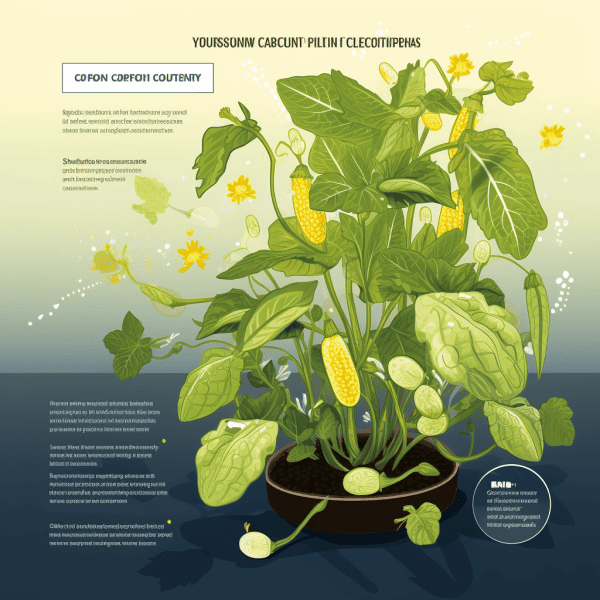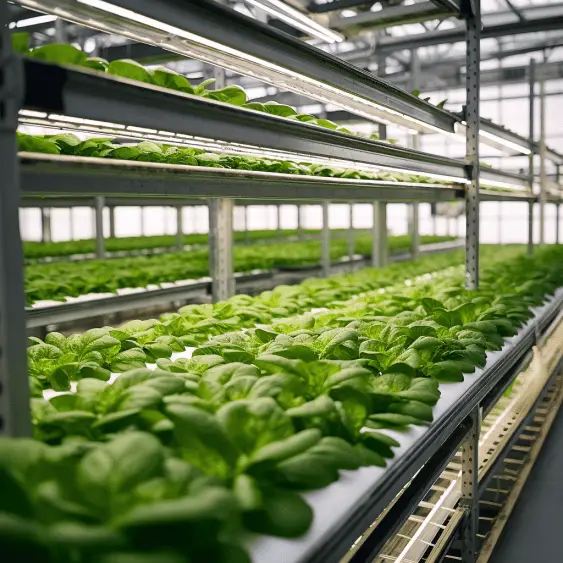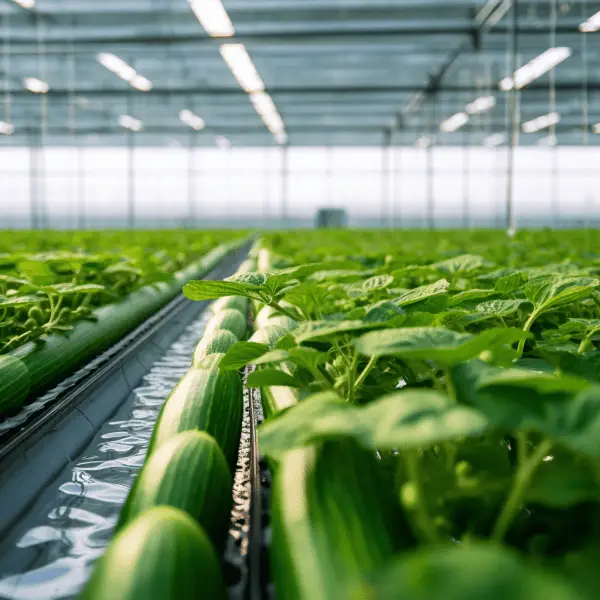Always encountering these common issues in hydroponic cucumbers and pondering how to solve them? As an urban farmer who went all in on hydroponics, I learned the hard way just how tricky cukes can be to grow in water. Between nutrient deficiencies, pollination troubles, and pest attacks, my first few cucumber crops were disasters! But through trial and error, I finally got the system dialed to churn out bountiful, delicious cukes.
Let me take you on my hydroponic cucumber journey. When I first set up my PVC pipe system and popped those seedlings in, I was thrilled watching the vines take off. But once flowers appeared, my excitement turned to dismay as they withered and fell off, leaving me without a single female cucumber. I tried again and again, tweaking the nutrients and pollinating by hand with no luck. I was about ready to give up on hydro cukes for good!
But I’m stubborn, so I kept experimenting. I researched obsessively, changed my nutrients, controlled the environment more carefully, and finally—success! My current hydro cucumber crop is so abundant I can’t give them away fast enough.
Ready to learn from my mistakes? Stick with me and I’ll share the solutions that transformed my cucumber crop. Let’s make your hydroponic cucumbers thrive!
KEY TAKEAWAY
What are the common issues in hydroponic cucumbers and how to solve them?
Common issues in hydroponic plant as cucumber cultivation include nutrient deficiencies, root rot, and pest infestations (1). These can be solved by maintaining proper nutrient levels, ensuring good drainage, and implementing pest control measures such as regular monitoring and using organic insecticides.
Identifying Common Hydroponic Cucumber Problems
Growing bountiful, healthy cucumbers hydroponically comes with its fair share of challenges. Based on my own troubleshooting journey, here are some of the most common issues to look out for:
Poor pollination – Lack of pollinators can prevent female flowers from producing cucumbers. Make sure there are enough bees/other pollinators accessing your greenhouse, or pollinate by hand.
Nutrient deficiencies – Common deficiencies include nitrogen, calcium, and magnesium. Monitor pH and EC levels closely to maintain optimal nutrient availability.
Pests – Spider mites, broad mites, and whiteflies love attacking cucumber plants. Watch for webbing, stippling damage, honeydew residue, and insects under leaves.
Diseases – Powdery and downy mildew, along with fungal stem rots can spread rapidly in humid hydroponic environments. Prune affected parts immediately and improve air flow.
The key is frequent monitoring to catch issues early before they devastate your crop. Inspect roots, leaves, flowers, and fruits vigilantly for any signs of distress. With quick action, most common hydro cucumber problems can be resolved!
Dealing with Powdery Mildew in Hydroponic Cucumbers

Nothing kills my hydroponic cucumber joy faster than the dreaded white powdery patches of powdery mildew. Cooler temperatures and high humidity create the perfect environment for this fungal disease to thrive. Here’s how I tackle it (2):
- Improve greenhouse ventilation and air circulation to reduce humidity.
- Prune and discard any infected leaves or vines to prevent spreading.
- Spray plants preventatively with organic antifungals like neem oil before infection starts.
- Introduce beneficial fungi that compete with powdery mildew – Bacillus subtilis works well.
- Ensure proper plant spacing for good airflow.
With vigilance to cull affected parts and better climate control, powdery mildew can be contained. An ounce of prevention is worth a pound of cure when it comes to protecting your hydro cucumber crop!
Managing Gummy Stem Blight in Hydroponic Cucumbers

Nothing looks more unappetizing than the gummy brown lesions caused by gummy stem blight. This fungal disease thrives in high humidity and can spread rapidly. Here’s my strategy for combating it:
- Remove and destroy any infected leaves and vines immediately to contain it.
- Increase greenhouse ventilation and use fans to decrease humidity.
- Avoid working around plants when they are wet to limit spore spread.
- Apply preventative copper fungicide sprays as needed.
- Ensure adequate plant spacing for airflow.
- Sanitize hydroponic equipment between crop cycles.
Gummy stem requires vigilance to stop its sticky spore-oozing tracks. Through strict hygiene and environmental controls, we can keep cukes clean and thriving in hydroponics.
Controlling Two Spotted Spider Mites in Hydroponic Cucumbers
As a lover of arachnids outdoors, I hate to kill any of my eight-legged friends. But the damage wrought by two spotted spider mites forces my hand. Here’s how I defeat these tiny devils while protecting other beneficial insects:
- Check leaf undersides for mites and fine webbing. Remove heavily infested leaves.
- Hose down plants and introduce predatory mites that feast on spider mites but leave crops alone.
- Use selective miticides like abamectin in extreme cases. Avoid broad spectrum pesticides.
- Rinse dust and debris off frequently – spider mites cling to dirty plants.
With vigilance and quick responses, we can control mite populations and nurture a healthy cucumber sanctuary for all creatures…minus those few unwanted spider squatters!
Understanding Broad Mite Issues in Hydroponic Cucumbers
Recently I discovered broad mites are another minuscule pest that can wreak havoc on hydroponic cucumber crops. The nymphs of these tiny insects suck juices from leaves and fruit, causing distorted growth. Here’s what I learned about broad mite control:
- Inspect for bronzing, curling leaves and deformed, bitter fruits which indicate their presence. Use a hand lens to spot the microscopic mites.
- Remove and destroy affected leaves and fruits promptly. Their populations explode rapidly.
- Introduce predatory mites like Amblyseius swirskii that feast on broad mites.
- Spray affected plants with insecticidal soap or neem oil carefully to smother mites while avoiding beneficials.
These microscopic vampires can sneak up quickly, so be vigilant. Through early detection and integrated pest management, we can keep them from destroying tender cuke crops!
Pollination Techniques for Hydroponic Cucumbers
Lack of pollinators is a common hydroponic cucumber pitfall. With no bees buzzing around, female blossoms wither up fruitlessly. Here are solutions I use to achieve thorough pollination:
- Introduce bumble bee hives temporarily into the greenhouse when cukes start flowering. Screen intake vents first!
- If bees aren’t an option, use a soft brush or cotton swab to manually transfer pollen between flowers daily.
- Employ plant growth regulators to stimulate more female flowers.
- Vibrate vines gently to shake pollen free. Just don’t overdo it!
Don’t let poor pollination prevent your vines from bearing bountiful cucumbers. With a little creativity, we can ensure thorough fertilization to get those cukes growing!
Optimal pH Levels for Hydroponic Cucumbers
When growing cucumbers hydroponically, maintaining the optimal pH level in your nutrient solution is absolutely crucial. Through trial and error, I’ve found cucumbers thrive best within a pH range of 5.5 to 6.5 for maximum nutrient absorption. Here’s what I’ve learned about managing pH for healthy hydro cukes:
Cucumbers tend to prefer the slightly acidic side, so letting your pH drop too low below 5.5 can inhibit nutrient uptake and slow growth. Early on, my hydroponic reservoir pH kept decreasing to around 4.5 since I wasn’t monitoring routinely. My cucumber vines lacked vigor and the edges of leaves turned yellow – a sign of multiple nutrient deficiencies.
Once I started checking and adjusting pH daily to keep it between 5.5 and 6.0, the new growth looked much healthier. According to hydroponic guides, calcium, magnesium, and iron availability decreases rapidly once pH drops below 5.5. Keeping things just slightly acidic prevents nutrient lockout.
On the other end, if your pH climbs too high above 6.5, you may see slower plant development, canker lesions on fruits, and susceptibility to disease. High pH makes phosphorus less available and reduces overall absorption.
To maintain ideal cucumber-growing hydroponic conditions, test pH frequently and correct it with pH Down or pH Up solutions as needed. Target 5.5 to 6.5 for optimal nutrition and crop health! Consistent monitoring makes all the difference.
Tips to Prevent and Address Nutrient Deficiencies in Hydroponic Cucumbers
Cucumbers are heavy feeding plants with needs for high levels of nitrogen, phosphorus, calcium, and magnesium. Without adequate nutrition, your hydroponic cucumber vines and fruits will fail to thrive. Here are some tips to prevent deficiencies:
- Use a complete hydroponic nutrient formula tailored for fruiting vegetables. I use General Hydroponics Flora Series.
- Check pH routinely to ensure optimal nutrient availability. Deficiencies often accompany pH issues.
- Replace reservoir water every 1-2 weeks to replenish depleted nutrients and prevent salt buildup.
- Consider foliar spraying micronutrients like calcium, iron, and magnesium to prevent blossom end rot and other issues.
- Increase nitrogen levels if leaves are light green and vines are stunted.
If you do notice deficiencies like yellowing leaves or poor fruit set, correct pH immediately and adjust your nutrient strength. With good preventive nutrition, your hydroponic cukes will be mighty!
Frequently Asked Questions
What do overwatered cucumbers look like?
It’s easy to overdo it with watering when growing cucumbers, especially in hydroponic systems. Overwatering deprives roots of oxygen and encourages disease. Here’s how to recognize when your cucumber crop is getting too much water:
- Leaves yellow and droop or wilt, even when soil appears wet
- Stems and crowns feel mushy or rotten
- White fungal growth on leaves or soil
- Stunted vine growth and reduced fruit set
- Fruit rots quickly from blossom end
If your cukes are showing these symptoms, cut back on watering frequency and quantity. Improve drainage in soil gardens if needed. In hydroponics, increase aeration with air stones. Addressing overwatering quickly helps cukes bounce back!
How do you know if you have a magnesium deficiency in cucumbers?
A magnesium deficiency can sneak up on cucumbers, causing poor growth and yellowing between leaf veins. Here are the telltale signs:
- Leaves turn yellowish between veins but veins stay green
- Lower leaves affected first, progressing up vine
- Leaves curl downward at edges
- Reduced vine growth and slowed fruit production
- Bitter taste of fruits in severe cases
Check pH to ensure magnesium is available for uptake. Consider foliar spraying Epsom salts or adding magnesium sulfate to nutrient tanks. Proper magnesium ensures vigorous vines and plentiful cucumber fruits!
Why are my cucumber plants struggling?
If your cucumber vines are stunted and leaves are yellowing or wilting, there are a few common culprits to investigate:
- Over or under watering – ensure proper soil moisture or hydroponic pH/nutrients
- Low nitrogen – add nitrogen fertilizer or amend nutrients
- Nutrient lockout from improper pH
- Hungry pests like spider mites sucking sap
- Disease like powdery mildew
- Insufficient pollination and fruit set
- Cold temperatures or lack of sun exposure
Closely inspect vines, leaves, and fruits to pinpoint the issue. Address watering needs, nutrients, pests, disease, and environment to get plants thriving again!
Conclusion
In the end, with careful attention to nutrients, pollination, and pest control, hydroponic cucumbers can produce prolifically. Don’t get disheartened by early struggles. With tweaks to your system and environment, those vines will be cascading with fresh cukes in no time.
I hope sharing my experiences helps you overcome the common hydroponic cucumber pitfalls. We’re all learning together, so please share your own tips and lessons learned too! My best advice – start small, stay vigilant, and have faith in the power of perseverance. Before you know it, you’ll be rolling in cukes.
Now let’s go make all that trial and error worthwhile! A bounty of crunchy, vine-fresh cucumbers awaits. Get those seeds started and savor the fruits of your labor soon.
References
- https://www.greenhousegrower.com/production/everything-you-need-to-know-about-hydroponic-cucumber-production/#:~:text=Powdery%20mildew%20can%20be%20one,whiteflies%2C%20or%20thrips%20on%20cucumbers.
- https://scienceinhydroponics.com/2017/09/how-to-prevent-problems-with-powdery-mildew-in-hydroponic-crops.html
Related Articles
Was this helpful?

Crystal Erickson is an agriculture enthusiast and writer with a passion for sustainable farming practices and community development. Growing up on a family farm in rural Iowa, Crystal developed a love for the land and a deep appreciation for the hard work and dedication required to make a farm successful.
After completing a degree in Agriculture and Environmental Science from Iowa State University, Crystal began her career as an agricultural journalist, covering stories and issues related to modern farming practices, crop management, and livestock production. She quickly established herself as a respected voice in the industry, known for her insightful reporting and thoughtful analysis.
Over the years, Crystal has written for a variety of publications, including Farm Journal, Successful Farming, and Modern Farmer, as well as contributing to several academic journals focused on sustainable agriculture and community development. Her work has been recognized with numerous awards, including the Iowa Farm Bureau’s Young Farmer Achievement Award and the National Association of Farm Broadcasting’s Farm Broadcaster of the Year.


